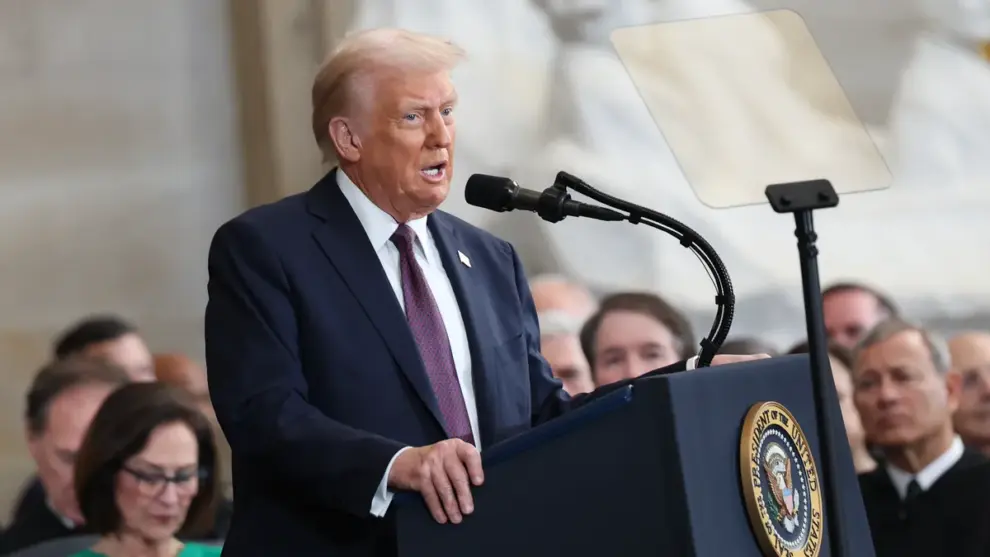Just days after being hailed by many as the “first bitcoin president,” Donald Trump’s recent announcement of sweeping global tariffs has triggered a significant downturn in the cryptocurrency market, with Bitcoin leading the slump. The flagship cryptocurrency has plummeted over 10% since the announcement, falling below the $78,000 mark on Sunday night after reaching a peak of nearly $110,000 earlier in the year when Trump assumed office for his second term. This sudden drop has left investors reeling and questioning the stability of digital assets in the face of traditional economic policies.
The sharp decline comes despite the widespread optimism within the cryptocurrency community following Trump’s re-election. A vocal supporter of the digital asset industry, Trump had promised to transform the United States into the “crypto capital of the planet.” His administration had taken several steps seemingly favorable to the sector, including appointing regulators considered friendly to crypto and even initiating the creation of a government Bitcoin reserve. Trump himself has also ventured into the crypto space, promoting a memecoin to his supporters.
However, the enthusiasm appears to have waned rapidly as the implications of the newly announced tariffs began to sink in. The tariffs, intended to reshape global trade, have instead injected uncertainty into the broader financial markets. This uncertainty has seemingly extended its reach to the cryptocurrency world, a sector often perceived as being somewhat insulated from traditional economic forces.
Market analysts suggest that the Bitcoin sell-off reflects a broader “risk-off” sentiment among investors. In times of economic uncertainty, investors tend to shed assets perceived as riskier, and Bitcoin, despite its growing mainstream adoption, is still largely viewed as a speculative investment. The current market behavior indicates that many investors are treating Bitcoin more like a tech stock, which they readily sell during periods of market turbulence.
“Crypto is weird, but it’s mostly correlated to optimism and risk appetite,” commented Haseeb Qureshi, a venture capitalist focused on cryptocurrencies, in a recent social media post. He further added that this optimism is currently “crumbling under Trump’s silence” regarding the impact of his tariffs on the digital asset market.
The impact of Trump’s tariffs is not limited to Bitcoin alone. The broader cryptocurrency market has also experienced a significant downturn. Ethereum, the second-largest cryptocurrency, has seen an even steeper decline, falling by over 12%. Other major cryptocurrencies like XRP and Solana have also registered substantial losses, highlighting the interconnectedness of the digital asset market and its sensitivity to macroeconomic factors.
This market-wide slump has resulted in a significant reduction in the overall capitalization of the cryptocurrency market, with over $160 billion wiped out in a single day. This mirrors the trends observed in the traditional stock markets, where major indices also experienced substantial declines following Trump’s tariff announcement. The tech-heavy Nasdaq Composite, for instance, saw a significant drop, further reinforcing the notion that investors are adopting a cautious approach across various asset classes.
The situation presents a complex scenario for the cryptocurrency industry. While Trump’s initial pro-crypto stance had fueled hopes of a favorable regulatory environment and increased adoption in the United States, his trade policies appear to be having an unintended negative consequence. The tariffs are creating economic headwinds and dampening investor sentiment, which in turn is impacting the price of cryptocurrencies.
Some analysts believe that this downturn could be a temporary reaction to market uncertainty. They argue that Bitcoin’s fundamental value proposition as a decentralized store of value remains intact. However, the current price action underscores the vulnerability of digital assets to broader market forces and the influence of macroeconomic policies.
The long-term implications of Trump’s tariffs on the cryptocurrency market remain to be seen. If the tariffs lead to a prolonged period of economic slowdown or trade tensions, it could further dampen investor appetite for risk assets like Bitcoin. On the other hand, if the market perceives the tariffs as a short-term disruption, Bitcoin and other cryptocurrencies could potentially recover.
For now, the cryptocurrency community, which had largely embraced Trump as a champion, finds itself in a precarious position. The “first bitcoin president” is now overseeing a significant downturn in the market, raising questions about the resilience of digital assets in the face of traditional economic policies and the unpredictable nature of global trade. Investors will be closely watching the market’s reaction in the coming days and weeks to gauge whether this is a temporary dip or the beginning of a more prolonged bear market. The unfolding situation serves as a stark reminder that even in the seemingly detached world of cryptocurrency, traditional economic policies can cast a long shadow.
The decline also highlights the inherent volatility of the cryptocurrency market. Despite its increasing adoption by institutional investors, Bitcoin remains a highly speculative asset, prone to significant price swings in response to market events and investor sentiment. This volatility can be both a source of opportunity and risk for investors, underscoring the importance of careful research and risk management in the cryptocurrency space.
Furthermore, the current situation may prompt a re-evaluation of the perceived correlation between cryptocurrency prices and traditional financial markets. While some argue that Bitcoin acts as a hedge against inflation and economic uncertainty, the recent price drop suggests a stronger correlation with risk appetite in broader markets. This correlation could have significant implications for how investors view and allocate capital to digital assets in the future.
As the global economic landscape continues to evolve under the influence of new trade policies, the cryptocurrency market will likely remain sensitive to these developments. Investors should stay informed about macroeconomic trends and policy changes to better understand the potential impact on their cryptocurrency investments. The era of the “crypto president” may have begun with enthusiasm, but the recent market downturn serves as a sobering reminder of the complex interplay between the digital asset market and the traditional global economy.




